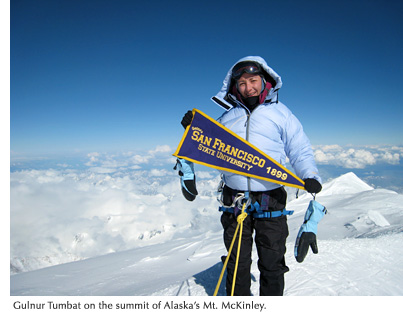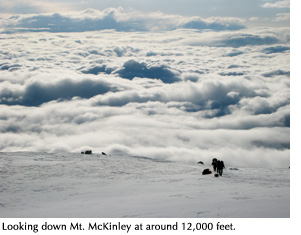|
 Assistant Professor of Marketing Gulnur Tumbat's June climb to the summit of
Alaska's
Mt. McKinley not only fed her passion for mountain climbing, it contributed to
her expanding expertise on the relationship between those who provide and those
who purchase physical risk. Though the experienced climber's previous research
includes interviews with climbing leaders and consumers at a base camp on Mount
Everest, this was the first time that her research included participating in
an expedition as a client-climber. Assistant Professor of Marketing Gulnur Tumbat's June climb to the summit of
Alaska's
Mt. McKinley not only fed her passion for mountain climbing, it contributed to
her expanding expertise on the relationship between those who provide and those
who purchase physical risk. Though the experienced climber's previous research
includes interviews with climbing leaders and consumers at a base camp on Mount
Everest, this was the first time that her research included participating in
an expedition as a client-climber.
The
7,000-foot ascent from the Kahiltna base camp to McKinley's summit
at 20,320 feet allowed Tumbat to keep field notes on what is negotiated
between the service providers (guides) and their customers. She plans
to publish her findings and present them at leading professional
conferences.
With
15 years of experience climbing the mountain peaks in her native
Turkey, and in Russia's and Georgia's Caucasus mountains, Tumbat
is well aware that the contract between adventure providers and consumers
bears little resemblance to that of providers and consumers of other
products or services. In this case there are no guarantees or refunds.
"The
interaction between a service provider and a customer takes a long
time under a lot of stress where the stakes are high," said
Tumbat. "Marketing
and media can lead a consumer to perceive that an expedition is easily
achievable...so, expedition guides have to manage their client's
expectations and actually negotiate the risk involved." Leaders
will not risk the safety of the entire team if it turns out that
some cannot physically
complete the trip.
 On
Tumbat's McKinley ascent, a team member needed to be rescued by helicopter
after succumbing to altitude sickness. Another lost
the confidence to finish and was guided back to base camp. Abrupt
changes in weather or a natural disaster can easily destroy a consumer's
investment of time and money and deny personal achievement. On
Tumbat's McKinley ascent, a team member needed to be rescued by helicopter
after succumbing to altitude sickness. Another lost
the confidence to finish and was guided back to base camp. Abrupt
changes in weather or a natural disaster can easily destroy a consumer's
investment of time and money and deny personal achievement.
"For
me, a trip like this one is a study in risk acculturation...by that
I mean how one acclimates to risk over time." The expedition
was also a good place to study the nature of how people feel about
what they think they deserve. "People
believe that they can buy everything," said Tumbat. "They may
feel that they deserve to reach the summit, because they paid for
it. Realistically speaking, if the summit is achieved it's a bonus,
not a promise."
Tumbat
and the remainder of the team were lucky enough to achieve their
bonus. At the summit the sun was shining while the temperature hovered
between zero and 28 degrees below Fahrenheit. In addition to the
items necessary for a successful climb, Tumbat carried a San Francisco
State pennant and the Turkish flag. A teammate took photos of her
with each item. With this, Tumbat became the first Turkish woman
to summit Mount McKinley. She
might also be the first to unfurl the SF State colors on the tallest
peak on the North American continent.
--
Denize Springer
 |
